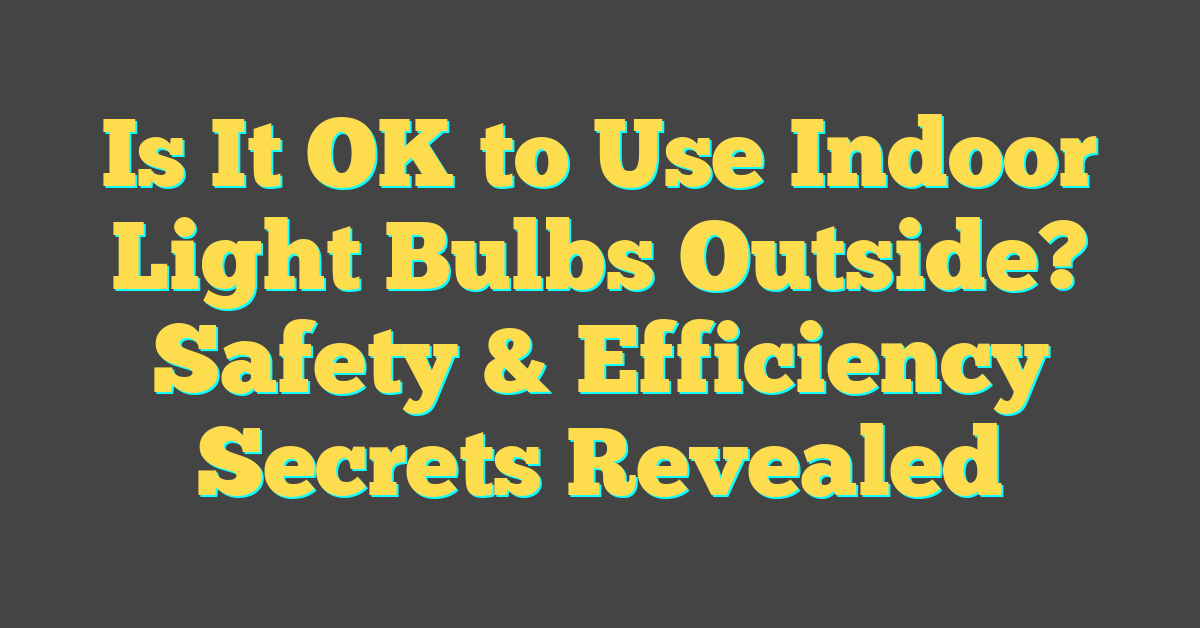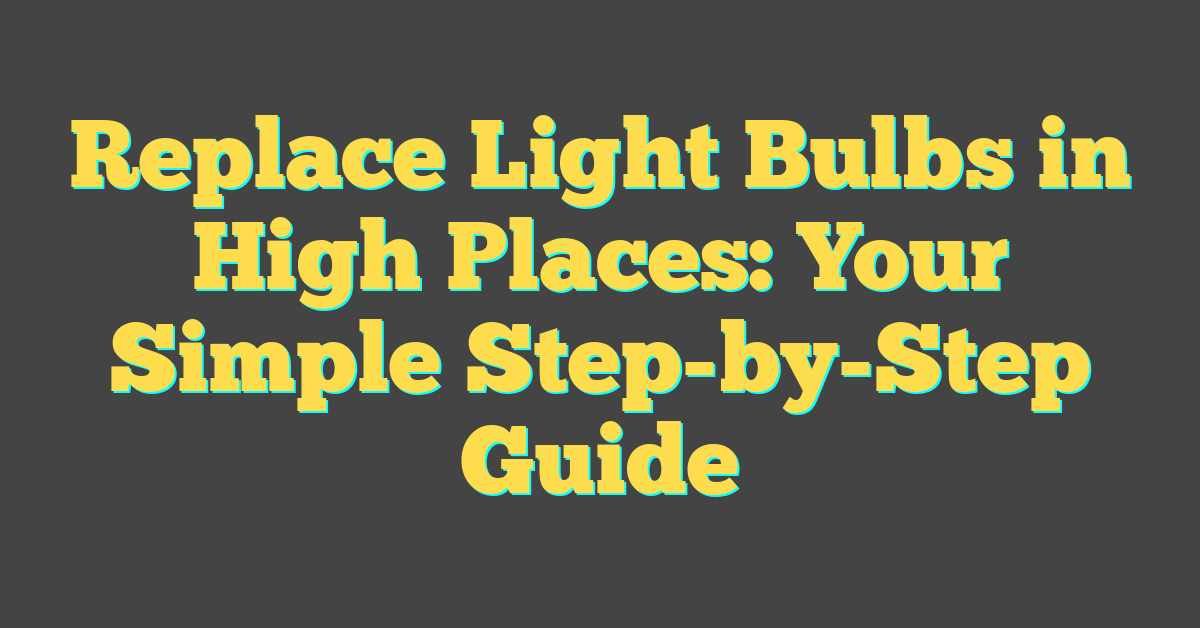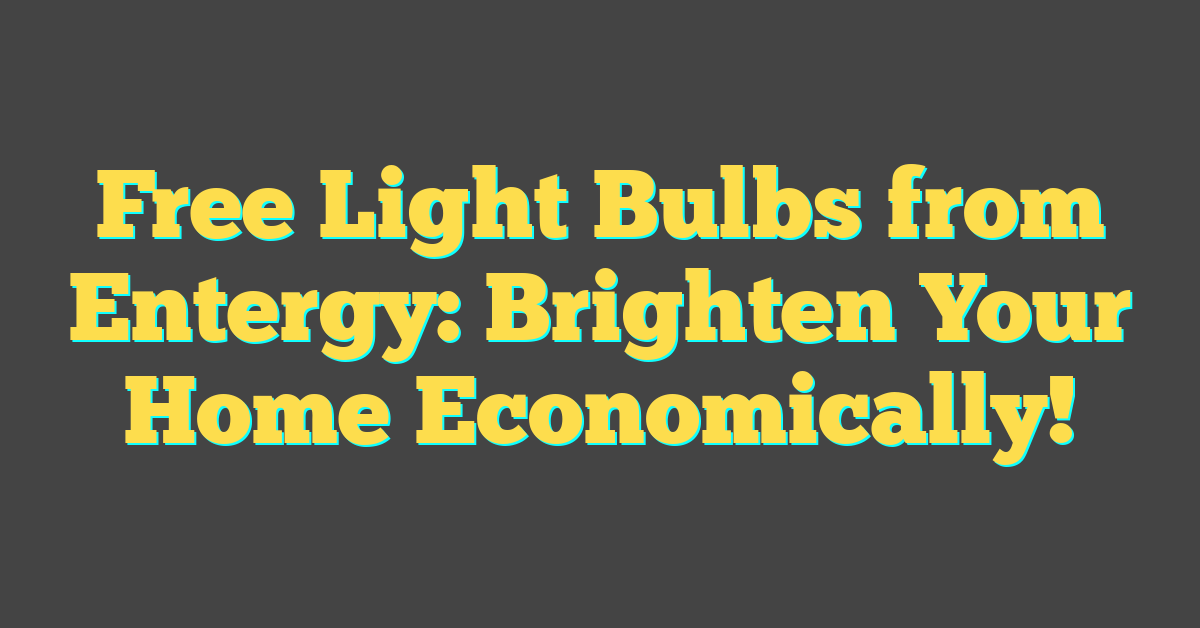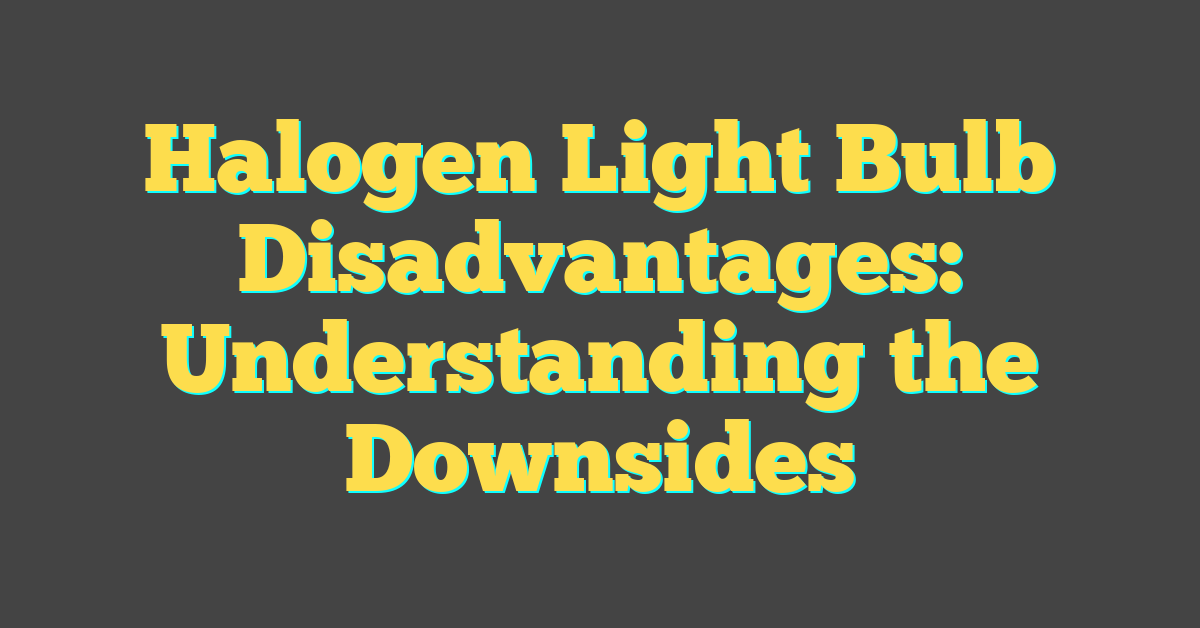Ever found yourself in a pinch, needing to light up your outdoor space but only indoor bulbs at hand? You’re not alone! It’s tempting to just screw one into your patio fixture and call it a night, but is that really a bright idea?

Outdoor lighting sets the mood for evening barbecues and illuminates your path home, but using the right bulb is key to longevity and safety. Before you reach for that indoor bulb, let’s shed some light on whether it’s up to the challenge of outdoor living.
Potential Risks of Using Indoor Light Bulbs Outside
When you’re considering swapping indoor bulbs into an outdoor setting, it’s not just about whether they’ll turn on. Safety and durability are the top concerns. Outdoor conditions are no tea party for a bulb that’s built for the cozy indoors.
First up, weather is a big deal. Indoor bulbs aren’t designed to face the elements like their outdoor counterparts. Moisture can be a real party crasher in this scenario. When water gets cosy with electricity, it’s not just a flicker and a pop you’re dealing with; you’ve got potential for electrical shorts and worse, a fire hazard. And remember, regular indoor bulbs might also sweat it out in extreme temperatures.
Next, let’s talk about thermal shock. It might sound like something from a sci-fi movie, but it’s the not-so-fun effect of drastic temperature changes. Imagine a hot bulb meeting the cold rain. That sudden temperature drop can cause an indoor bulb to say goodbye much sooner than you’d expect, or even crack on the spot.
Also, don’t overlook that outdoor fixtures have special designs. They’re basically the knights in shining armor for light bulbs, protecting them from the dragons of rain, dust, and bugs. Plopping an indoor bulb into a fixture that’s not designed to cuddle it properly means it’s going to be like a knight without a shield.
Bulb Lifespan and Efficiency
When you opt for an indoor bulb outside, you’re also saying hello to a shorter life expectancy for your light source. Here’s a quick look at the lifespan difference:
| Type of Bulb | Average Lifespan (Indoor) | Average Lifespan (Outdoor) |
|---|---|---|
| Incandescent | 900–1,000 hrs | Significantly less |
| LED | 15,000–25,000 hrs | Less due to elements |
And let’s not ignore energy efficiency. Outdoor bulbs are often built to be energy savers, so by using an indoor bulb outside, you may see a spike in your energy bills.
Differences Between Indoor and Outdoor Light Bulbs

As you embark on your next home DIY project, keep in mind that the core differences between indoor and outdoor light bulbs can influence both performance and safety. It’s crucial to understand these distinctions to ensure that your lighting solutions are not only effective but also safe.
Construction and Material Durability play a pivotal role in how light bulbs are classified. Outdoor light bulbs are constructed with more robust materials to withstand harsh weather conditions. They’re often encased in shatter-resistant coatings and have stronger bases to prevent corrosion, which is particularly important in areas with high humidity or salty sea air. Conversely, indoor bulbs may have thinner glass and are not built to combat the elements.
Power Requirements also differ significantly. Outdoor bulbs are generally designed to emit brighter light, which can mean they have higher wattage needs. This increased brightness is essential for outdoor spaces, where larger areas need illumination.
Safety Certifications such as UL ratings for wet and damp locations are typically found on outdoor bulbs. These ratings ensure that the bulbs have been tested to handle moisture without shorting out or posing a fire hazard. Indoor bulbs lack these certifications, as they are intended for use in controlled environments where exposure to weather is not a concern.
When selecting a light bulb, whether for a cozy indoor atmosphere or a secure outdoor space, always check for the proper certifications and make sure the bulb suits the intended environment. Here are a few key aspects to look for:
- UL Rating: Verify if the bulb is rated for outdoor use
- Wattage: Compare the energy requirements
- Material: Look for weather-resistant features
Remember, expert lighting can transform a space, but the wrong choice can leave you in the dark. Keep these differences in mind to choose the right bulb for the right setting, ensuring longevity and efficiency, while keeping your energy bills in check.
Exposure to Outdoor Elements
« How Often Do Light Bulbs Explode? Prevent Shocks Now
Does Light Bulbs Make You Darker? Debunking Skin Tone Myths »

When you’re considering whether to use indoor light bulbs outside, it’s crucial to understand how exposure to outdoor elements affects their performance. Out in the open, light bulbs face environmental challenges that can significantly shorten their lifespan and efficacy.
Temperature Fluctuations are a major concern. Indoor bulbs aren’t built to handle the extreme cold or heat that can be typical in outdoor settings. These fluctuations can cause indoor bulbs to crack or burst—a mishap that’s not only inconvenient but potentially dangerous.
Next, consider Moisture and Humidity. Outdoor bulbs typically have tighter seals and are constructed with waterproof or water-resistant materials. If moisture seeps into an indoor bulb, it can lead to electrical shorts or corrosion. Your safety should always be a priority, and ignoring the distinction between indoor and outdoor bulbs could pose a risk.
Wind and Physical Damage also pose threats. An unexpected hailstorm or a few strong gusts can damage the fragile construction of an indoor bulb that’s been used outdoors. Outdoor fixtures often have sturdier coverings to protect the light bulbs from being damaged by debris.
Lastly, don’t overlook the Ultraviolet (UV) Light that can degrade the materials of an indoor bulb not meant for prolonged sun exposure. Outdoor bulbs are generally designed to resist UV damage, which means they’ll not only last longer but will also maintain a consistent light output.
Here’s a quick comparison of features between indoor and outdoor bulbs:
| Feature | Indoor Bulbs | Outdoor Bulbs |
|---|---|---|
| Material Durability | Less Durable | More Durable |
| Temperature Resistance | Low | High |
| Moisture Resistance | Not Waterproof | Waterproof/Water-Resistant |
| Physical Protection | Minimal | Designed for Impact |
| UV Resistance | Low | High |
If you’re a DIY enthusiast or simply aiming to brighten up your porch, be aware that not all light bulbs are created equal. Knowing the difference ensures that you give each space the appropriate glow—safe, efficient, and sure to complement your home’s charm.
Impact on Energy Efficiency

When you’re eyeing that indoor bulb for an outdoor fixture, you’ve got to consider energy efficiency. It’s not just about the immediate illumination; it’s about how the bulb performs under varying outdoor conditions. After all, who doesn’t want to save on that electricity bill?
First up, let’s talk lumens and watts. Indoor bulbs, while designed for a stable environment, might struggle outside. They’re a bit like homebodies—you take them out into intense temperatures and they don’t hold up as well. What happens then? They work harder to maintain brightness, and you’ve got increased energy usage.
Outdoor bulbs, on the other hand, are the adventurers of the light bulb world. Built for endurance, they maintain their luminosity without breaking a sweat—or the bank. But there’s more to it than just toughness, it’s science. With materials that handle heat and cold, these bulbs provide consistent light output without needing extra power to combat the elements.
Here’s a quick glance at how outdoor conditions impact energy efficiency:
- Extreme Temperatures: Highs and lows can cause indoor bulbs to fluctuate in brightness, using more energy.
- Moisture: Can short-circuit indoor bulbs, leading to inefficiency or total failure.
- Frequent On/Off Cycles: Outdoor sensors or motion detectors can shorten the lifespan of indoor bulbs not designed for such use.
And, of course, let’s not forget the economic aspect. Inefficient bulbs not only hike up your energy costs but might also need replacing more often. So while it may seem like a small detail, choosing the right bulb for outdoor use can make a real difference to your wallet over time.
You might be thinking about LED bulbs. They’re the superheroes in the energy efficiency story, right? Absolutely! LEDs are incredibly versatile and generally fare better outdoors compared to their incandescent or halogen cousins. But even LEDs have their kryptonite. Not all LED bulbs are created equal, so look for those designed for outdoor use, to really max out on those energy savings.
In your quest for perfect lighting, pay attention to the designations on the bulb packaging. You’ll often find ratings for outdoor use, which consider not just energy efficiency but also longevity in the face of Mother Nature’s whims. By honing in on the right bulb for the job, you’ll keep your space brightly lit and energy smart without any unnecessary waste.
Safety Concerns with Indoor Bulbs Outside

Using the wrong bulb can do more than run up your energy bill; it can pose significant safety risks, especially when you’re trying to repurpose indoor bulbs for outdoor settings. As an avid DIY enthusiast and lighting expert, you know how crucial it is to respect the design limitations of indoor bulbs when used outside.
Firstly, indoor bulbs aren’t built to withstand the elements like their outdoor counterparts. When exposed to moisture or extreme temperature changes, the likelihood of failure increases. This means not only can the bulb blow out, but it could potentially lead to electrical shorts. This scenario becomes particularly dangerous if the exposed electrical components encounter water, which might very well happen outdoors.
Moreover, many indoor light fixtures are not sealed against insects and dust. When these fixtures are used outside, pests can get inside, potentially causing the bulb to malfunction or even break. Imagine all the hassle if you had to constantly clean out the dead bugs or debris – it’s not the most pleasant of tasks, and it’s completely avoidable with the right outdoor fixtures.
Another point to consider is the heat generated by indoor bulbs. They often operate at higher temperatures and when enclosed in an outdoor fitting not designed for such heat output, it can become a fire hazard. Always check the fixture’s rating and never exceed the recommended wattage; it’s better to err on the side of caution.
Energy efficiency drops sharply with indoor bulbs used outdoors due to them working overtime to maintain brightness in unsuitable conditions. While this isn’t a direct safety concern, it’s an operational factor that can affect overall system safety and longevity. In the long run, this can lead to increased maintenance and the possibility of more frequent bulb replacements.
When planning your next outdoor lighting project, take a moment to consider these factors. Look for bulbs specifically designated for outdoor use and save yourself the headache of potential safety and efficiency issues. Remember, the right bulb not only saves you time and money but ensures a safer environment around your home.
Conclusion
So you’ve got the scoop on why it’s best to stick with outdoor bulbs for your exterior lighting needs. Remember, the right bulb not only ensures your safety but also keeps your energy bills from skyrocketing. Don’t let a simple oversight dim your outdoor experience. Go ahead and invest in those outdoor-specific bulbs. Your wallet—and peace of mind—will thank you.
Frequently Asked Questions
What is the main difference between indoor and outdoor light bulbs?
Indoor light bulbs are made for stable, controlled environments, whereas outdoor light bulbs are designed to withstand harsher conditions, including extreme temperatures, moisture, and frequent on/off cycles.
Can indoor bulbs be used outside?
Indoor bulbs can physically be used outside, but it isn’t recommended due to their lack of resistance to outdoor conditions, which can lead to reduced efficiency, safety risks, and shorter lifespan.
Why do indoor light bulbs struggle outside?
Indoor light bulbs struggle outside because they are not built to handle extreme temperatures, moisture, or the frequent on/off cycles caused by outdoor lighting fixtures’ sensors or timers, resulting in decreased performance and efficiency.
What are the safety concerns with using indoor bulbs outside?
Safety concerns include the risk of electrical shorts due to moisture, malfunction owing to pests, and increased fire hazards due to the bulb’s inability to handle outdoor conditions.
How can I ensure the light bulb I am using outside is safe and energy-efficient?
Ensure you are using bulbs specifically designed for outdoor use, check the fixture’s rating, and never exceed the recommended wattage. Outdoor bulbs will have materials and construction suitable for the environment, which enhances safety and efficiency.




